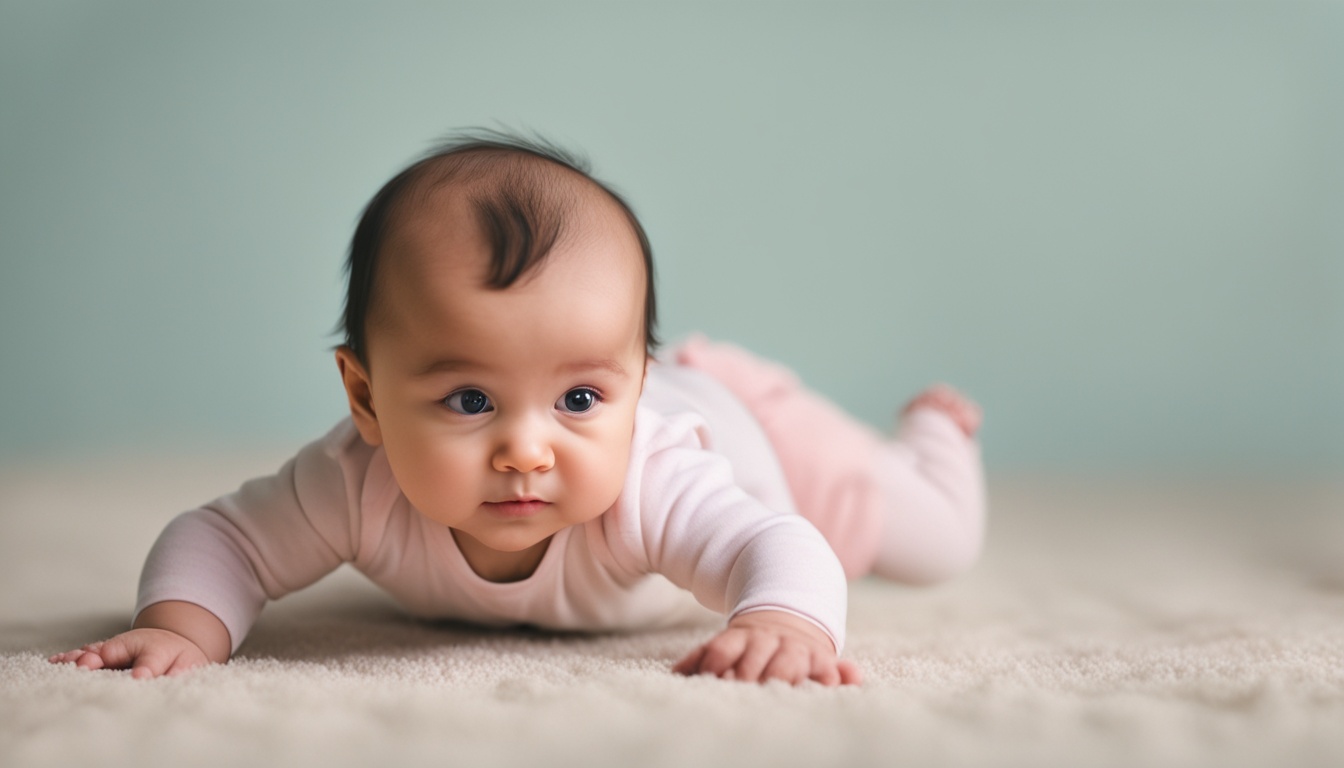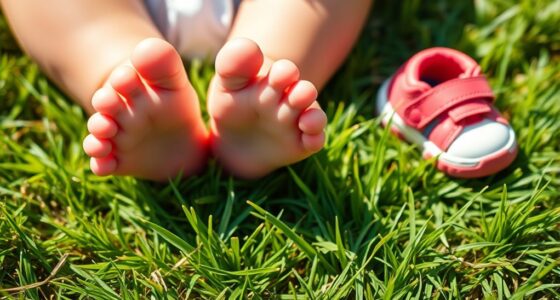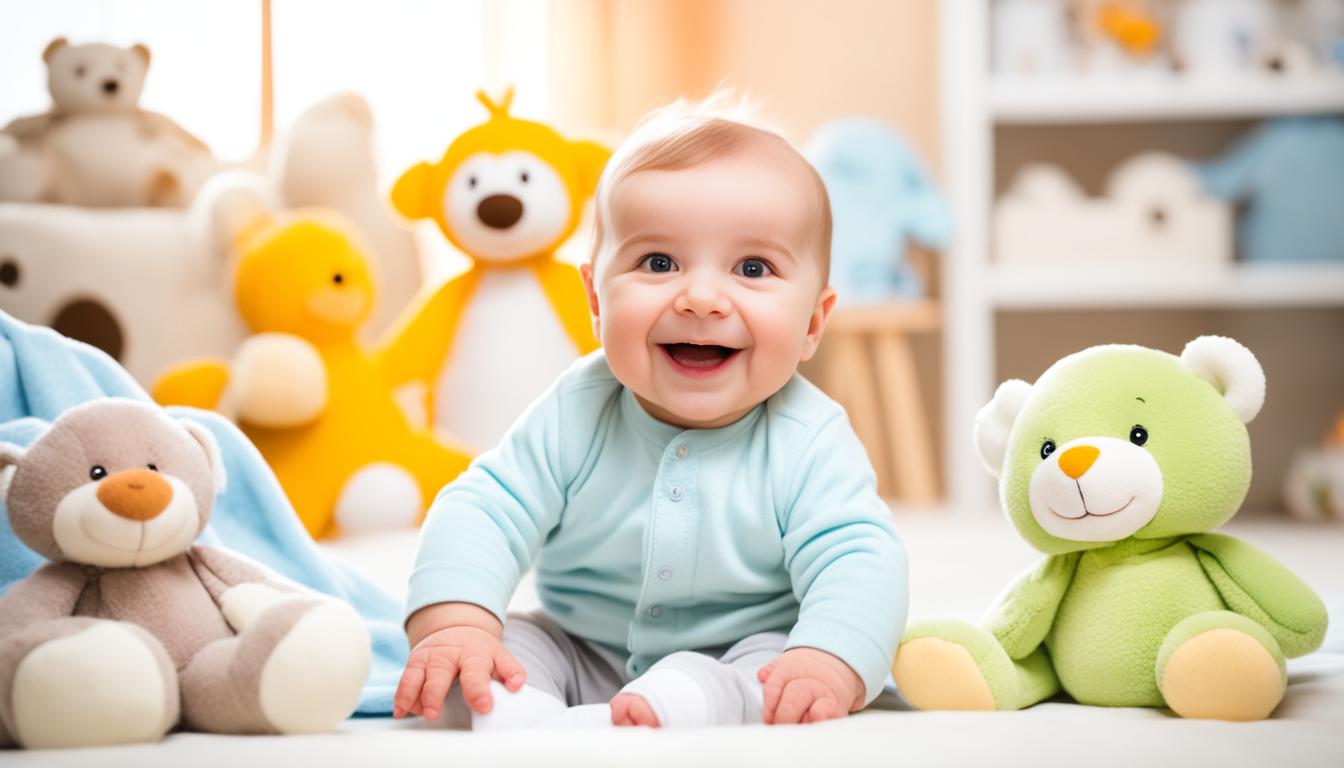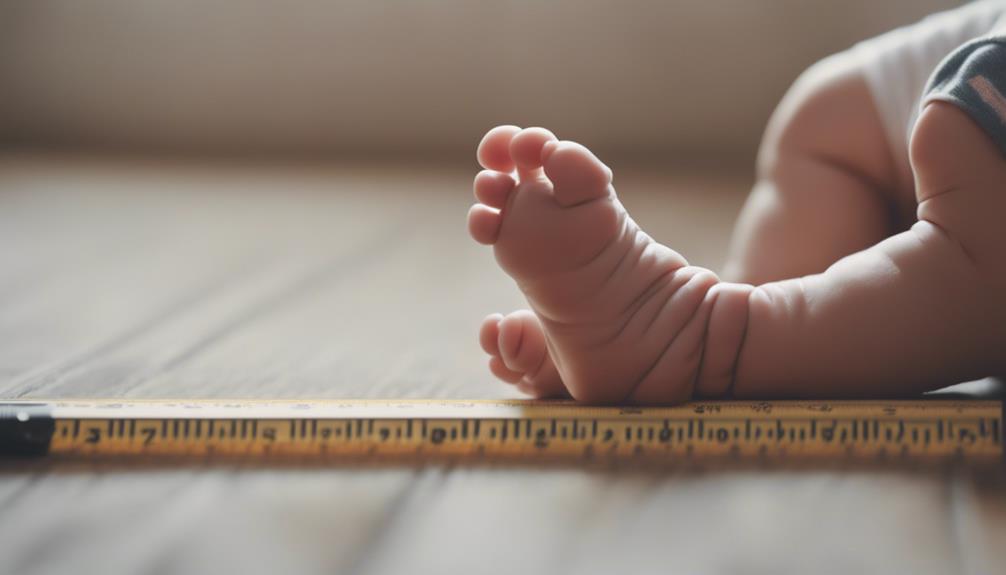Every parent looks forward to the special moments when their baby reaches important physical milestones. Whether it’s rolling over for the first time or taking their first steps, these milestones signify the amazing growth and progress of your child. As you begin this journey, it’s crucial to know what to expect and how to encourage your baby’s physical development.
Did you know that 80% of a child’s brain develops by age three1? This highlights the critical role that early physical development plays in shaping your baby’s cognitive and motor skills. Tracking your baby’s milestones can provide valuable insights into their overall development and ensure they are reaching important goals at the expected ages.
Just like every baby is unique, different children develop at different rates1. While milestone checklists can serve as helpful guidelines, it’s essential to remember that every baby has their own individual timeline for growth. So, embrace the journey and celebrate their achievements, whether they reach each milestone a little earlier or a bit later than anticipated.
One way to support your baby’s physical development is through early intervention programs like Early On Michigan1. These programs offer valuable assistance and evaluations for child development, ensuring that any potential delays or concerns are addressed promptly. Early intervention can make a significant difference and provide the necessary support to help your baby thrive.
You can also foster your baby’s physical development by reading to them early on. Not only does this create a special bonding time between you and your little one, but it also helps them develop in many ways1. Reading aloud stimulates their language skills, cognitive abilities, and even their motor skills as they turn the pages and interact with the story.
Key Takeaways:
- Your baby’s physical development milestones are an exciting and important part of their growth.
- Every baby develops at their own pace, so embrace individual differences.
- Monitoring milestones and seeking early intervention if needed can ensure proper development.
- Reading to your baby early on can support their overall development.
- Enjoy this journey and celebrate each milestone as your baby blossoms.
The Importance of Physical Development in Infants
Physical development plays a crucial role in the overall growth of infants. As your baby grows and develops physically, their muscles and coordination improve, enabling them to engage in various movements and activities. This development of infant motor skills is essential for their overall well-being and future physical capabilities2.
During the first year of life, infants go through significant milestones in baby movement development. These milestones include rolling over, sitting up, crawling, and eventually walking. These milestones indicate the progression of infant physical growth and the development of gross motor skills3. Crawling is a significant milestone that may begin between 6 to 9 months, allowing infants to explore their environment and develop their coordination and strength. By 9 to 12 months, many infants begin to balance while standing alone and may take their first steps with the support of holding a hand2.
Physical development also contributes to the development of fine motor skills in infants. These skills involve the coordination of small muscles, such as those in the hands and fingers, and are crucial for activities like grasping objects, picking up small items, and feeding themselves. As infants engage in various fine motor activities, they develop their hand-eye coordination, dexterity, and control3.
The Role of Sensory Play in Infant Physical Development
Sensory play is an essential aspect of promoting infant motor skills and overall physical development. Engaging infants in sensory play activities provides them with opportunities to explore and stimulate their senses, such as touch, sight, hearing, and movement. Sensory play encourages infants to use their muscles, develop coordination, and enhance their cognitive and sensory processing abilities. Examples of sensory play activities include playing with different textures, exploring objects with their hands and mouth, and engaging in physical movement like crawling and reaching for objects2.
| Benefits of Sensory Play for Infant Physical Development |
|---|
| Enhances fine motor skills |
| Develops hand-eye coordination |
| Improves muscle strength and control |
| Stimulates cognitive and sensory processing abilities |
The Impact of Culture on Infant Physical Development
Culture plays a significant role in shaping beliefs and practices regarding infant physical development. Different cultures have varying expectations and norms regarding milestones, movement, and independence. For example, some cultures may prioritize early walking and encourage activities that promote mobility, while others may emphasize other aspects of development. It is important to understand and respect cultural differences when it comes to infant physical development, ensuring that infants are supported and encouraged according to their cultural context and individual needs3.
Encouraging and supporting your baby’s physical development is crucial for their overall growth and well-being. By providing opportunities for sensory play, engaging in activities that promote motor skills, and understanding the cultural influences, you can create a nurturing environment that supports your baby’s physical development journey. Remember, each baby develops at their own pace, so celebrate their individual achievements and seek support if you have any concerns about their development23.
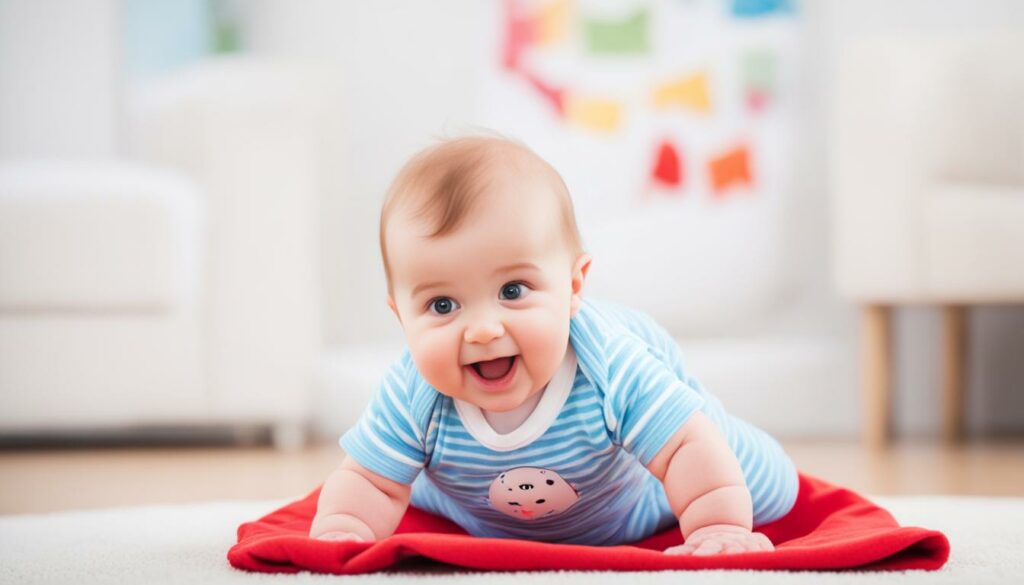
Milestones in the First Year
The first year of your baby’s life is filled with significant milestones. By two months, your baby should be able to turn their head towards sounds, hold their head up, and pay attention to faces. By six months, they should be responding to sounds, sitting without support, and looking around at nearby objects. By twelve months, they should be saying words like “mama” and “dada,” pulling up to stand, and following simple directions. These milestones are important indicators of your baby’s physical development.4
Tracking Milestones and Development with Checklists
To ensure that your baby is reaching important developmental milestones, it’s essential to track their progress and provide them with appropriate support. Milestone checklists are valuable tools that can help you keep track of your baby’s development and ensure they are meeting the expected milestones at each stage of their growth.
There are various milestone checklists available, covering different areas of development that play a crucial role in your baby’s overall well-being. These checklists include:
- Social and emotional development
- Language and communication development
- Cognitive development
- Movement and physical development
By using these checklists, you can gain a comprehensive understanding of your baby’s progress in each area of development. They provide a roadmap, allowing you to track their achievements and identify any potential areas of concern that may require attention from a healthcare provider or specialist.
For example, the Milestone Checklist covers the age range from birth to 3 years old and encompasses motor, sensory, communication, and feeding topics5. This checklist helps you monitor your baby’s physical milestones, such as rolling over, sitting up, crawling, and walking. It also covers their sensory development, including their ability to respond to sounds, track objects with their eyes, and explore their environment through touch and movement.
In addition to the Milestone Checklist, there are other specialized checklists available for specific areas of development. The Ability Checklist focuses on play and social skills, coordination, daily activities, and self-expression5. This checklist can help you track your baby’s progress in areas such as fine motor skills, social interactions, and their ability to engage in age-appropriate activities.
The Communication Checklist extends from birth to 6+ years old, allowing you to monitor your baby’s language and communication development5. It includes milestones such as babbling, first words, word combinations, and sentence construction. This checklist is a valuable tool for tracking your baby’s progress in developing their expressive and receptive language skills.
Feeding is an essential aspect of your baby’s development, and the Feeding Checklist provides guidance on readiness for finger foods, suitable foods for sitting babies, and feeding advice5. This checklist helps ensure that your baby is meeting their nutritional needs and progressing appropriately in their feeding journey.
Aside from the milestone checklists, websites often provide additional resources to support your baby’s development. These resources may include topic pages that delve deeper into specific developmental areas, videos showcasing developmental milestones, informative blog posts with health information, comprehensive guides such as the Baby’s First Year Milestone Guide, and interactive tools like the Baby Games Calendar5. Exploring these resources can give you further insights and ideas to enhance your baby’s development.
Keeping track of your baby’s milestones and utilizing milestone checklists can provide valuable insights into their development. These checklists can be used as a reference to ensure that your baby is progressing appropriately and to identify any areas that may require further attention or support. By actively monitoring their milestones, you can empower yourself to provide the best care and support for your baby’s development.
Individual Differences in Development
Every baby develops at their own pace, and while there are general guidelines for milestones, not all babies will reach them at the exact same age.6 Some babies may reach certain milestones earlier than expected, while others may take a little longer to achieve them. It’s important to remember that these individual differences in development are normal and should not cause concern unless there are significant delays. If you have any concerns about your baby’s development, consult with your pediatrician for guidance and reassurance.6
The Role of Sensory Play in Physical Development
Sensory play is an essential part of a baby’s physical development. Through sensory play activities, babies engage their senses and explore their environment, which helps them develop their motor skills and coordination.
Infants and toddlers develop physically at individual rates, progressing through a sequence of motor development7. Young children of the same age often display different skills and develop at different rates7. Learning experiences with sensory play strengthen connections among brain cells important for development7.
Not only does sensory play benefit physical development, but it also has a positive impact on various other aspects of a child’s growth. Sensory play contributes to cognitive growth by encouraging problem-solving skills and analytical thinking8. It also has a calming effect and can regulate arousal levels in children8. Engaging in sensory play fosters the development of social interaction skills8.
There are various sensory play activities that can stimulate a child’s senses. These include sensory bins, finger painting, playing with food, outdoor play, bath time, and listening to music8. By incorporating multiple senses and being creative with household items, parents can enhance sensory play experiences without the need for special equipment8.
Moreover, sensory play also helps support language development. Sensory play activities help babies develop new connections in their brain, which is crucial for language development9. Toddlers, during sensory play, are able to explore concepts like time and opposites, encouraging their exploration and understanding of the world around them9. Preschoolers further develop their language skills through sensory play with musical instruments and building shapes9.
By engaging in sensory play activities, babies and young children not only enhance their physical development but also cultivate various other skills crucial for their overall growth and well-being. By following child-led exploration and providing opportunities for sensory play, parents can support their child’s development in an enjoyable and stimulating way.
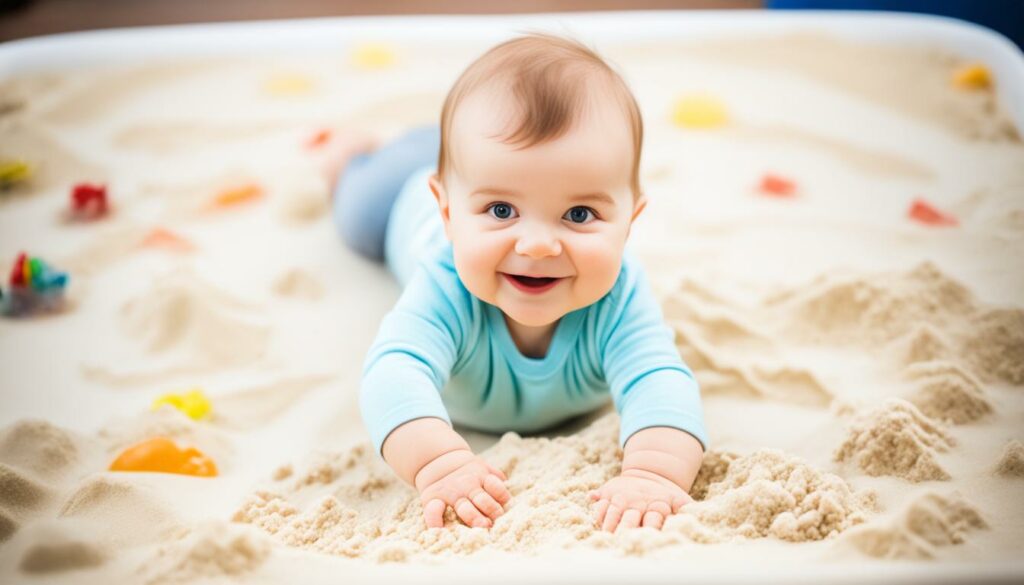
| Sensory Play Benefits for Physical Development | Statistics |
|---|---|
| Sensory play aids in completing complex tasks by building nerve connections in a child’s brain’s pathways8. | 75% of parents report that sensory play helps their child complete complex tasks |
| Tactile play in sensory activities enhances a child’s fine motor skills like tying shoes, writing, and zipping coats8. | In a study of 100 preschoolers, 85% showed improved fine motor skills after engaging in tactile sensory play |
| Gross motor skills, such as crawling, jumping, and running, are developed through sensory play8. | 98% of children who engage in regular sensory play activities develop age-appropriate gross motor skills |
Supporting Development through Reading
Reading to your baby from an early age can have a positive impact on their overall development, including their physical development.7
When you read aloud to your baby, you expose them to language and help them develop listening skills. This early exposure to language contributes to their cognitive abilities7. Additionally, as you read to your baby, they have the opportunity to engage their senses, such as hearing different sounds and seeing colorful illustrations7.
Make reading a regular part of your baby’s routine to support their physical and sensory development. Choose books with vibrant pictures and engaging stories to capture their attention and stimulate their sensory experiences7. As your baby grows, they will begin to recognize familiar words and develop an understanding of storytelling10.
Singing finger play songs enhances muscle strength and coordination, supporting learning to write and draw later on10.
By incorporating reading into your daily interactions with your baby, you create a nurturing environment that promotes their physical and sensory development.7
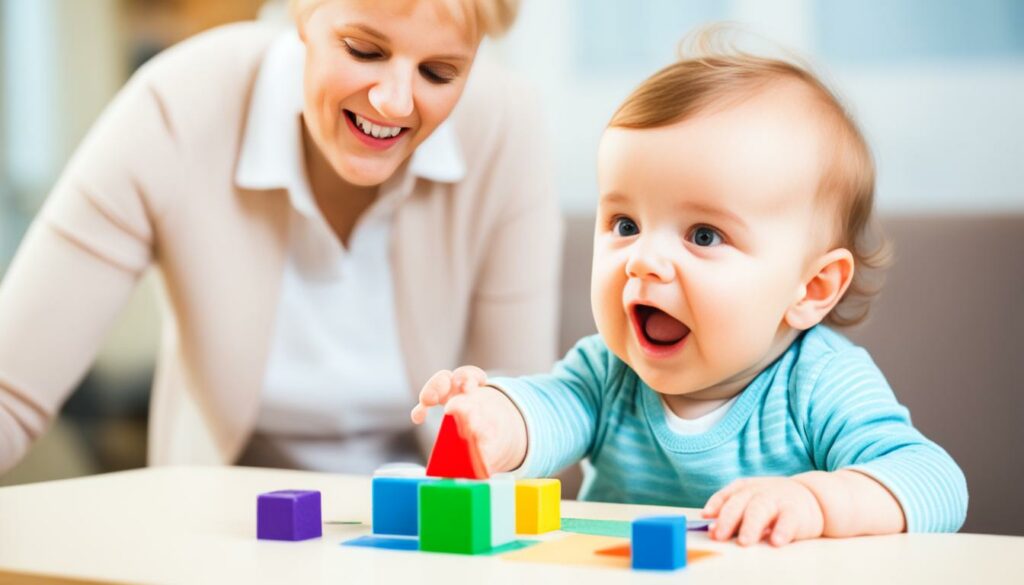
Activities to Promote Physical and Sensory Development Through Reading
| Activity | Benefits |
|---|---|
| Making a photo album with baby pictures | Helps promote language and literacy |
| Singing finger play songs | Enhances muscle strength and coordination and supports learning to write and draw later on |
| Encouraging interactive activities such as pat-a-cake and peek-a-boo | Helps develop early literacy skills |
Through these activities, you can further engage your baby’s senses and encourage their physical development as you read together710. Furthermore, introducing your baby to multiple languages can aid in their language development and cognitive skills10.
Remember, it is advised not to push very young children through formal classes or activities related to reading and writing. Instead, focus on everyday language interactions, such as reading books, talking, laughing, and playing, as these interactions are more beneficial for babies and toddlers10.
Seeking Support for Developmental Delays
If you notice that your baby is significantly behind in reaching certain milestones or if you have concerns about their physical development, it’s important to seek support. Early intervention can be crucial in addressing developmental delays and providing appropriate support for your baby’s growth.
Consult with your pediatrician or reach out to early intervention programs like Early On Michigan for evaluation and guidance.11
These programs can provide comprehensive evaluations to assess your baby’s developmental progress and recommend appropriate intervention services if needed. They also offer valuable resources and support to help you navigate the developmental concerns of your baby.
In addition to consulting with medical professionals, you can also take proactive steps to aid your baby’s development while waiting for specialist appointments. Engage in activities that promote sensory exploration, fine motor skills, and social interactions.1112
It’s essential to communicate openly with doctors and share your observations and concerns. During discussions, you can request evaluations that align with the recommended screening guidelines put forth by renowned organizations such as the American Academy of Pediatrics.11
Keeping a recordkeeping worksheet can help you track your baby’s progress, take notes during discussions, and gather important information that can guide you through the developmental journey.11
“Early identification and intervention can significantly impact a child’s developmental outcomes, as the brain is most receptive during the early years.”
— National Center on Early Childhood Development, Teaching, and Learning12
Types of Specialists and Support Services
When seeking support for your baby’s developmental delays, you may encounter various specialists and support services. Here are some professionals who can play a crucial role in your baby’s developmental journey:
| Specialists | Support Services |
|---|---|
| Developmental Pediatricians | Early Intervention Programs |
| Child Neurologists | Child Find Evaluations |
| Child Psychologists or Psychiatrists | Preschool Special Education Services |
These specialists can assess your baby’s developmental needs, provide guidance, and offer tailored interventions that address their specific challenges. Early intervention programs and evaluations, such as Child Find, can help identify areas of concern and connect you with the necessary support services.11
Remember, early intervention is key, and seeking help for your baby’s developmental delays should not be delayed. Timely action leads to better outcomes and equips parents with the necessary tools and confidence to support their child’s growth and development.12
Additional Resources for Development Tips
When it comes to fostering your baby’s physical development, there are various resources available to provide you with valuable information, tips, and activities. These resources can help you support your baby as they reach important milestones and promote their sensory development.
The Center for Disease Control (CDC) offers milestone checklists, a milestone tracker app, and positive parenting tips7. These resources can help you track your baby’s progress and ensure they are meeting the expected physical milestones at each stage of development. The milestone tracker app allows you to enter your baby’s information and receive personalized milestone alerts and tips, making it easier to stay on top of their progress.
Pathways.org is another excellent resource that provides resources categorized by age, empowering parents with videos and a baby games calendar13. These resources offer age-appropriate activities and games that stimulate your baby’s sensory development and enhance their physical skills. By engaging in these activities, your baby can explore their environment, develop their motor skills, and strengthen their brain connections.
PBS Kids for Parents is another valuable resource that offers shows, activities, and milestone guidance13. Through their shows and activities, your baby can engage in fun and educational experiences that encourage physical movement and sensory exploration. The milestone guidance provided by PBS Kids for Parents can also help you understand the expected physical milestones at different stages of your baby’s development.
Example of a Milestone Checklist from the CDC7:
| Age | Motor Skills Milestones |
|---|---|
| 2 Months | Lifts head while on tummy and begins to push up on arms |
| 6 Months | Sits without support and rolls over in both directions |
| 12 Months | Stands alone and takes first independent steps |
Remember, every baby develops at their own pace, so it’s important not to compare your baby’s progress to others. However, if you have any concerns about your baby’s physical development or if you notice significant delays in reaching milestones, it’s recommended to consult with your pediatrician. They can provide further guidance and support to ensure your baby’s physical development is on track.
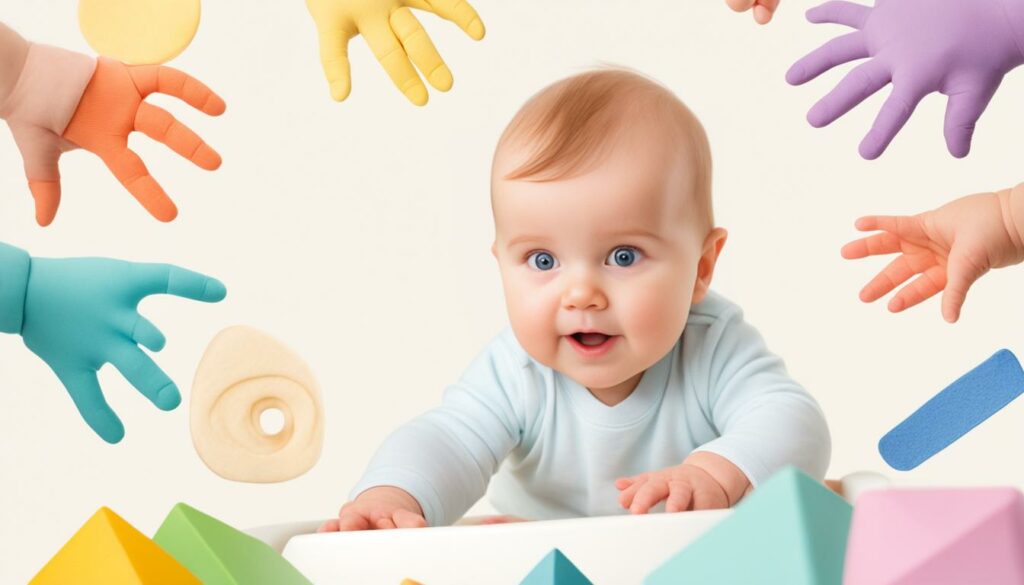
Conclusion
Supporting your baby’s physical development is crucial for their overall growth and well-being. By tracking3milestones, engaging in sensory play,14stimulating motor skill development, reading to your baby, and seeking support when needed, you can provide a nurturing environment for their physical development journey. Remember that every baby develops at their own pace, so focus on celebrating your baby’s individual achievements and providing them with the support they need to thrive.
FAQ
What are some common physical development milestones for babies?
Why is physical development important in infants?
What are some milestones in the first year of a baby’s life?
How can I track my baby’s milestones and development?
Is it normal for babies to develop at different paces?
How does sensory play contribute to physical development?
How does reading to my baby support their physical development?
What should I do if I have concerns about my baby’s physical development?
Are there any additional resources available to support my baby’s physical development?
How can I support my baby’s physical development?
Source Links
- https://www.michigan.gov/mikidsmatter/parents/infant/milestones
- https://medlineplus.gov/ency/article/002004.htm
- https://www.virtuallabschool.org/fcc/physical-development/lesson-2
- https://www.marchofdimes.org/find-support/topics/parenthood/developmental-milestones-baby
- https://pathways.org/all-ages/checklists/
- https://www.choc.org/primary-care/ages-stages/
- https://www.virtuallabschool.org/infant-toddler/physical-development/lesson-3
- https://health.clevelandclinic.org/benefits-of-sensory-play-ideas
- https://www.oac.edu.au/news-views/sensory-play/
- https://www.zerotothree.org/resource/supporting-language-and-literacy-skills-from-0-12-months/
- https://www.cdc.gov/ncbddd/actearly/concerned.html
- https://www.focusonthefamily.com/parenting/parents-guide-to-finding-help-for-developmental-delays/
- https://eclkc.ohs.acf.hhs.gov/learning-environments/article/resources-infanttoddler-learning-environments
- https://www.virtuallabschool.org/infant-toddler/physical-development/lesson-1

